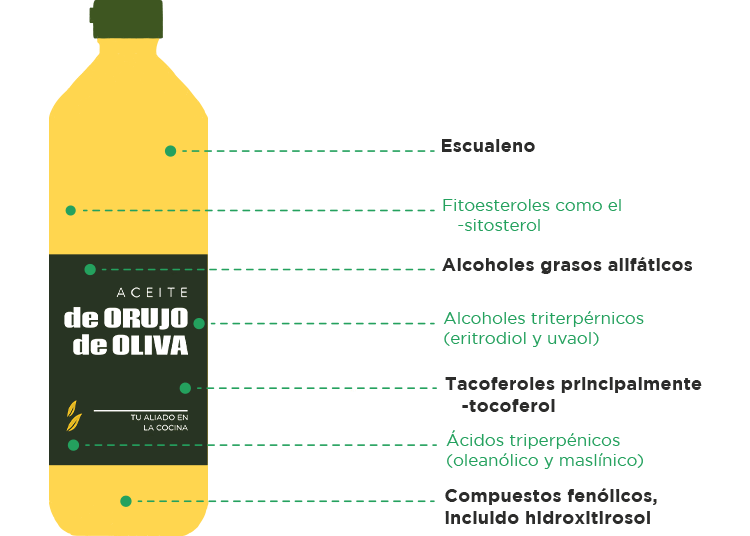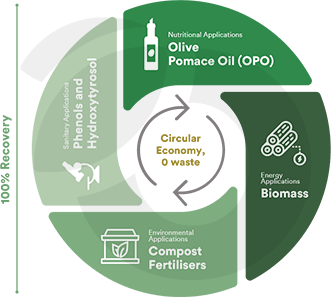Olive Pomace Oil
What is Olive Pomace Oil?
Getting the most from the olive
Olive Pomace Oil comes from the olive family, which is the principal guarantee of its nutritional quality and culinary performance. It is rich in oleic acid, contains antioxidants and other bioactive compounds that offer health benefits.
Its composition makes it ideal for frying, as it stands out for in terms of durability and stability. Its unbeatable performance for frying is backed by scientific studies that demonstrate that Olive Pomace Oil can be used more than twice as often as other vegetable oils.
Apart from being great for frying, it is a versatile alternative for sauces, stews and desserts thanks to its mild flavor.
Qualities that make it an economically attractive product for the hospitality and food industries and a must in any kitchen.

How do we produce it?
Olive Pomace Oil
Aprovechamiento integral de la aceituna
Olive Pomace Oil is obtained in three phases: extraction, refining and topping up, a process that ensures none of the olive fruit is wasted.
We start with the raw material, the wet fatty pomace paste, comprising water, skin, stone and any oil remaining after olive milling. After a sustainable extraction process, the remaining oil is recovered, refined and finally topped up or blended with extra virgin olive oil or virgin olive oil.
This process gives Olive Pomace Oil its differential properties: high nutritional quality and unbeatable performance.

Environmental value of Olive Pomace Oil
Valorization and Sustainability
Olive Pomace Oil is much more than a unique food product. The way it is produced generates zero waste, creating a circular economy and making the Olive Pomace industry environmentally friendly. Olive oil uses only 20% of the olive, the remaining 80% is pomace paste.
This paste is used in the olive pomace industry, where it is transformed into a range of valuable products, making the olive production chain fully sustainable.”
100% recovery of the olive
During the proper processing of the alpeorujo, most of it, 60%, evaporates in the form of water. The rest is put to valuable food, energy, environmental and sanitary applications.
- Food applications: around 2% is the crude oil that will be used to make Olive Pomace Oil.
- Energy applications: approximately 38% of the alpeorujo is converted into biomass, mainly in the form of orujillo and olive stones, used as an energy source both for internal consumption and for commercialisation. The olive pomace oil industry has implemented the use of renewable energies, like the generation of biomass from olive groves, and cogeneration with natural gas.
- Environmental applications: chemical fertilisers and compost for the fertilisation of soils and crops.
- Health applications: the industry also extracts other high value-added compounds with nutritional and cosmetic applications such as phenols or hydroxytyrosol, which are utilized by the pharmaceutical industry.


Olive Pomace Oil, the Smart Buy
The well-rounded alternative
Olive Pomace Oil combines quality, versatility and profitability, but also delivers huge environmental benefits. A well-rounded alternative with the potential to satisfy the most demanding professionals and consumers who are looking for an affordable oil that works well in the kitchen, is good for their diet and the environment.
Quality, health, flavor, profitability and sustainability, all these attributes are what make Olive Pomace Oil the smart buy.
